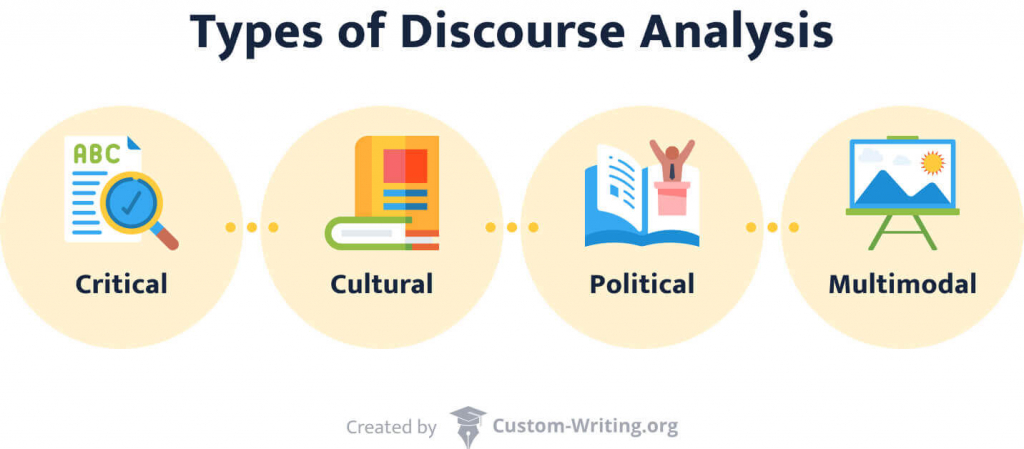In a discourse analysis essay, examples are more than just illustrations: they serve as the basis for demonstrating how language conveys social and historical meanings. Writing a discourse essay requires using examples of various texts to interpret the underlying message of what is being said.
If you need guidance to help you compose such a paper, you’ve come to the right place. In this article, our custom writing team will:
- Define discourse and its analysis
- Explain how to write a discourse analysis essay step by step
- Provide a model essay example
Read on to learn all about writing a discourse analysis paper. The samples on this page will serve as additional inspiration!
🤔 What Is a Discourse Analysis?
Discourse analysis is a technique used to study written and spoken language in its social context. It emerged in the late 20th century from the growing interest in qualitative research. The main purpose of discourse analysis is to understand the message and its implications. To achieve this, researchers study the text’s parts and the factors that influence people’s understanding of it.
Discourse analysis is deeply connected with linguistics, anthropology, sociology, socio-psychology, philosophy, communications studies, and literature. It challenges the idea that we should take language for granted and instead encourages more interpretative and qualitative approaches.
Discourse analysis is used in different fields to:
- describe organizational change
- grasp policies by analyzing them
- provide greater depth to qualitative accounting research
- use multiple fields to synthesize information
Why Is Discourse Analysis Important?
There are many reasons for learners to hone their discourse analysis skills. For instance, such analysis helps with the following:
- Building links with social reality. You will learn to see beyond the limiting conventions and surface-level meanings, enabling a deeper understanding of the social world.
- Capturing social constructs. By analyzing the dominant discourse, students can understand and challenge the power structures that shape and impose social norms.
- Transcending censorship. Most discourses are developed and regulated by censoring institutions, like the government, church, or other influential structures. Discourse analysis allows students to go beyond the dominant discourse and create a free and unique understanding of the world.
All this allows discourse analysis to serve as a powerful tool for deciphering the hidden tactics used to manipulate people through language and social customs. By deconstructing such discourses, you will learn to build your own unrestricted perception of the surrounding reality.
Content Analysis vs. Discourse Analysis
Content analysis and discourse analysis are research techniques that are often used interchangeably. However, there is a key difference between the two:
- Content analysis is quantitative. It focuses on studying and retrieving meaningful information from documents.
- Discourse analysis is qualitative. It focuses on how language is used in texts and contexts.
Discourse Analysis vs. Other Research Methods
Qualitative research is a broad area that offers many methodological choices besides discourse analysis, such as narrative, thematic, and content analyses, among others. Here’s what sets discourse analysis apart from them:
- In-depth exploration of speech acts. Discourse analysis allows researchers to tap into the performative power of language and the role of speech acts in shaping and reinforcing the dominant discourse. It is a valuable tool for understanding how verbal expressions influence perceptions of social norms and construct reality.
- Comprehensive contextual analysis. This approach provides a comprehensive and nuanced analysis of contextual richness. It examines the social, cultural, historical, and political factors that shape discourse and offers a deeper understanding of their influence.
- Deconstruction of power dynamics. Discourse analysis opens many avenues for evaluating the sources of social injustices and inequality in the dominant power structures and their limiting discourses.
- Versatile research applications. This methodology is universally adaptable to many research goals and subjects. It helps analyze social structures and interactions, particularly by examining how political rhetoric and communication tools shape complex social dynamics.
📝 When to Use Discourse Analysis: Examples
Here are some of the most exciting examples of using discourse analysis in research:
- Power dynamics and social structure analysis. Language is your clue to understanding power relations in society. By analyzing how dominant discourses are shaped and reinforced through language, you may identify the power structures behind this manipulative work.
- Context-specific communication. The functions of linguistic expression heavily depend on context. Thus, speech acts should be analyzed only in tandem with their contextual settings and a proper understanding of environmental influences.
- Identity and group dynamics. Language brings intricate processes of identity construction and group interactions to the surface. Through discourse analysis, you can decipher the nuances of how people define themselves in terms of gender, class, ethnicity, and other parameters.
- Rhetoric in media and popular culture. Mass media and pop culture play a huge role in constructing and manipulating discourses to instill dominant stereotypes and ideologies in the masses. By deconstructing media discourses, students can understand these mechanics of social impact.
- Conversational discourses. People communicate differently with various interlocutors in different settings. Discourse analysis can help decipher the nuances and factors of those distinctions.
- Evolution of language. Discourse analysis may also help you understand the change of language as a community’s tool of interaction and self-representation.
- Text and written communication analysis. Language is a powerful discourse-setting tool that skilled authors and speakers can manipulate to achieve their goals. Careful analysis of oral and written speech acts can help you understand those intentions.
Types of Discourse Analysis
Before you start working on your paper, it’s best to decide what type of discourse analysis you plan to do. It will influence your topic choice and writing techniques. Besides, it will make the whole process easier. Check out the main types below.

Critical Discourse Analysis
Critical discourse analysis (or CDA) is a cross-disciplinary methodological and theoretical approach. It focuses on the issues of power and inequalities in linguistic interactions between individuals and groups. It’s closely related to applied linguistics, cultural and social studies, anthropology, intercultural communication, and critical pedagogy.
Cultural Discourse Analysis
Cultural discourse analysis (or CuDA) is a method of studying culturally distinctive communication practices in our world. In the communication field, CuDA is most often used by scholars of Language and Social Interaction.
Political Discourse Analysis
Political discourse analysis (or PDA) focuses on the use of language in politics, political texts, and documents. It also includes the recipients of communicative political events, such as the citizens and the general public. Therefore, it can be said the discourse is located in both political and public spheres.
Multimodal Discourse Analysis
Multimodal discourse analysis is a technique that implies looking at multiple modes of communication such as text, color, and images. It studies how they interact with one another to create semiotic meaning. Each mode of communication plays a specific role in the analysis. A picture, for instance, can easily depict something that takes too long to describe in words.
👣 How to Do Discourse Analysis Step by Step
Now you are finally ready to start writing your discourse analysis. Follow our step-by-step guide, and you’ll excel at it.
Step #1: Choose the research question and select the content of the analysis.
Coming up with a clearly defined research question is crucial. While there’s no universal set of criteria for what makes a good research question, try to ensure that yours is:
- clearly states the purpose of the work;
- is not too broad or too narrow;
- can be investigated and has enough sources to rely on;
- allows you to conduct an analysis;
- is not too difficult to answer.
Step #2: Gather information.
Go through interviews, speeches, discussions, blogs, etc., to collect all the necessary information. Make sure to gather factual details of when and where the content you will use was created, who the author is, and who published it.
Step #3: Study the context.
This step involves a close examination of various elements of the gathered material.
- Take a closer look at the words used in the source text, its sentences, paragraphs, and overall structure.
- Consider 3 constructs of context: participants, setting, and purpose. These 3 characteristics reflect information about the individual, their emotional state, and their identity as members of a societal group.
Step #4: Review the results.
Once you’ve researched and examined all the sources, it’s time to reflect on your results and place your analysis in a broader context.
- To establish a broader context, you may consider what events have impacted the topic you are writing about and the consequences.
- Finally, draw conclusions that answer your research question.
Step #5: Make an outline.
Before you are all set with your discourse analysis, one last step is to write an outline. Usually, a discourse analysis essay consists of six parts:
📑 Example of Discourse Analysis Essay
Now that you know all about discourse analysis, we will introduce an example of a discourse analysis essay. From this sample, you can see what the layout of this kind of essay usually looks like.
- Introduction.
My project explores the problem of sexual violence, which continues to be a social issue, and the positive impact the #MeToo movement has made to solve it. #MeToo is a social movement that openly discusses the problem of violence and speaks up against sexual abuse and harassment. - Aim and research questions.
The guiding research question for my analysis is: what is the most significant positive change that came from the #MeToo movement? - The model of analysis.
My approach includes an analysis of tweets and the #metoo hashtag, as they help trace the movement’s development and reflect people’s honest opinions on it. I started with the essential tools: a laptop and a Twitter account. From there, I used the search bar to type in the hashtag #MeToo, and then I randomly selected a sample of 50 tweets. I coded the data based on the categories I produced while also being mindful that one tweet can fall into several categories. For that reason, all the tweets are coded with the appropriate numbers. - The data used.
Before working on categories, I researched factual information regarding the topic and examined literary materials published within 5 years. After reading these sources, I came up with 4 categories in order to make the coding process easier. The categories that I decided upon are:- Raising awareness,
- Victims getting financial restitution,
- Introducing protection/laws protecting workers,
- Banning nondisclosure agreements.
- Results.
The conducted research provided me with all the necessary information to illustrate the answer to my question. The conversations about sexual harassment and violence worldwide are being spread through the use of the hashtag #MeToo. This was shared through many news stories, events related to the topic of sexual harassment, and information referencing facts. - Conclusion.
In conclusion, a critical discourse analysis of 50 tweets illustrates the significant positive change that came from the #MeToo movement. This sample illustrates that thanks to the campaign, people’s awareness of the crimes of sexual assault has risen, as most tweets were coded as such. The sharing of this discourse is powerful in preventing the worldwide spread of sexual violence. It keeps the conversations going and raises awareness.
You might also want to check out the discourse analysis samples below.
- Dysphemism in Political Discourse Examples
- Historical Memory Discourse in Public Diplomacy
- Lincoln’s and Dickinson’s Rhetorical Discourses
✏️ Discourse Analysis Essay Topics
- Terrorism theories and media discourse
- The benefits of infographics in social media advertising
- Do better communication skills lead to the development of the social self?
- How can you make social media advertising successful?
- Possible causes of the Mayan civilization’s political collapse
- Commission of Education and Communication’s worldwide contribution
- Coach and athletes’ communication strategy
- Celebrities’ impact on politics
- Social media marketing for brand promotion
- What makes listening the most effective communication technique?
- Excessive social media usage and its consequences
- Web-based organizational discourses: climate change
- Media as a tool to cause intense emotions
- Verbal and nonverbal communication skills for presentations
- New media technologies and the development of relationships and communication
- Features and issues of the American political system
- Association between social media use and FOMO
- Communication issues between stakeholders
- Why is political opportunity theory essential for social movement studies?
- How do social media and the Internet connect people?
- How can communication be used for self-presentation?
- Does social media limit personal freedom?
- Hamlet’s universality and contemporary cultural discourse
- Is it possible to apply Goffman’s theory of the presentation of self in digital communication?
- The Democratic and Republican party’s position on the issue of terrorism
- How does social media affect families?
- How communication affects the individual’s development
- Characteristics of a political issue
- Ageism in media and society
- Possible mobile communication technologies of the future
- How does social media technology improve democratic processes?
- Persuasion and public communication
- The signs of social media addiction
- Psychometric approach and discourse analysis in the psychology of laughter
- The role of media in a political system
- Cultural differences in nonverbal communication
- The politically socialized vision of the world
- The negative effects of digital media platforms on the lives of young people
- Core beliefs of different political ideologies
- Approaches to overcome miscommunications in the workplace
- The effectiveness of social media tools for educational purposes
- Is technology a threat to face-to-face communication?
- What issues come with using electronic media?
- Difficulties connected with the development of communication technologies
Thanks for reading till the end! We hope you’ve enjoyed the article and found lots of helpful information. If you did, feel free to share it with your friends. We wish you good luck with the discourse analysis essay!
Further reading
- How to Write a Discursive Essay: Tips to Succeed & Examples
- Case Study Analysis: Examples + How-to Guide & Writing Tips
- How to Write a Literary Analysis Essay Step by Step
- How to Write a Rhetorical Analysis Essay: Outline, Steps, & Examples
❓ Discourse Analysis FAQs
What Is Literary Discourse Analysis?
Literary discourse analysis is a type of discourse analysis that deals with literature and is viewed as a relatively new approach to it. It integrates the analysis of literature and non-literary genres in an innovative study of discourse.
What Is a Rhetorical Discourse?
Rhetoric uses language to appeal to emotions to persuade, inform, or motivate the audience. Rhetorical discourse is used to study texts aimed at specific audiences. Such texts often try to convince or persuade people by using particular language and arguments.
How Do You Write a Discourse Community Analysis?
To write a discourse analysis of any community, you need to examine and understand it. Ask yourself these questions and try to identify the patterns:
- What ideas or concerns keep the community together?
- What kind of language does it use?
- Does it produce any written documents?
🔍 References
- Discourse: The University of Chicago
- Definition and Examples of Discourse: ThoughtCo
- Discourse: British Council: BBC
- Use Discourse Analysis: Emerald Publishing
- Discourse Analysis—What Speakers Do in Conversation: Linguistic Society of America
- Critical Discourse Analysis and Information and Communication Technology in Education: Oxford Research Encyclopedias
- Political Discourse Analysis: Exploring the Language of Politics and the Politics of Language: Research Gate
- Discourse Analysis and Everything You Need to Know: Voxco
- Multimodal Discourse Analysis: Diggit Magazine
![Precis Example, Definition, & Writing Guide [2025]](https://custom-writing.org/blog/wp-content/uploads/2022/02/education-concept-student-studying-brainstorming-campus-concept-close-up-students-discussing-their-subject-books-textbooks-selective-focus-284x153.jpg)


![Critical Analysis Essay Example & Writing Guide [2025]](https://custom-writing.org/blog/wp-content/uploads/2021/10/business-men-sitting-lawyers-s-desk-people-signing-important-documents-284x153.jpg)





![Critical Writing: Examples & Brilliant Tips [2025]](https://custom-writing.org/blog/wp-content/uploads/2021/02/fingers-note-report-journalist-filling-284x153.jpg)

